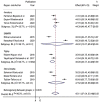Prevalence of episiotomy practice and factors associated with it in Ethiopia, systematic review and meta-analysis
- PMID: 35435068
- PMCID: PMC9019356
- DOI: 10.1177/17455057221091659
Prevalence of episiotomy practice and factors associated with it in Ethiopia, systematic review and meta-analysis
Abstract
An episiotomy is one of the most commonly performed obstetrics surgeries indicated in emergencies during the second stage of labor like fetal distress, dystocia, and tight perineum. As a result, this systematic review and meta-analysis aimed to assess the prevalence of episiotomy practice and associated factors in Ethiopia. Ten cross-sectional studies with a total population of 3718 were included in this study. The search was done using online databases like PubMed, HINARI, Web of Science, other gray, and online repositories of Universities. All the included papers were extracted and appraised using the standard extraction sheet format of JOANNA Briggs Institute. The Cochran Q-test and I2 statistics test were used to test the heterogeneity of studies. To detect the publication bias of the included studies, a funnel plot and Egger's test were used. The pooled prevalence of episiotomy practice and the odds ratio with a 95% confidence interval were presented using forest plots. The overall pooled prevalence of episiotomy practice was 45.11% (95% CI; 37.04-53.18; I2 = 96.3%). Prolonged second stage of labor (OR: 4.79, 95% CI: 3.03, 7.57), face presentation (OR: 4.26, 95% CI: 1.21, 15.07), birth weight > 4000 g (OR: 6.71, 95% CI: 3.14-14.33), instrumental delivery (OR: 4.26, 95% CI 2.95, 6.14), and primiparity (OR: 3.70, 95% CI: 1.90, 7.2) were factors associated with episiotomy practice. The overall prevalence of episiotomy practice was higher in Ethiopia compared to studies conducted in other countries. The prolonged second stage of labor, face presentation, birth weight > 4000 g, instrumental delivery, and primiparity of women were the factors associated with episiotomy practice. Therefore, efforts should be made to prevent routine episiotomy practice through creating awareness, adjusting national guidelines, affecting the World Health Organization episiotomy policy, and monitoring the activities of the health care facilities in executing the protocols.
Keywords: Ethiopia; episiotomy; indications; meta-analysis; obstetrics surgeries; systematic review.
Conflict of interest statement
Figures




References
-
- World Health Organization. WHO recommendations: intrapartum care for a positive childbirth experience. Geneva: World Health Organization, 2018. - PubMed
-
- Graham ID, Carroli G, Davies C, et al.. Episiotomy rates around the world: an update. Birth 2005; 32(3): 219–223. - PubMed
-
- Fodstad K, Staff AC, Laine K. Episiotomy preferences, indication, and classification—a survey among Nordic doctors. Acta Obstet Gynecol Scand 2016; 95(5): 587–595. - PubMed
-
- Marty N, Verspyck E. Perineal tears and episiotomy: surgical procedure—CNGOF perineal prevention and protection in obstetrics guidelines. Gynecol Obs Fertil Senol 2021; 46(12): 948–967. - PubMed
-
- De Leeuw J, De Wit C, Kuijken J, et al.. Mediolateral episiotomy reduces the risk for anal sphincter injury during operative vaginal delivery. BJOG An Int J Obstet Gynaecol 2007; 115(1): 104–108. - PubMed
Publication types
MeSH terms
LinkOut - more resources
Full Text Sources
Research Materials

